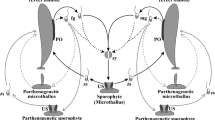Abstract
Reproduction, development and morphological variation of the marine green algaCaulerpa racemosa var.peltata from the southern part of Japan were studied in culture in the laboratory. Anisogamous biflagellate male and female gametes were produced monoeciously and copulated with each other. Settled zygotes became spherical and increased in volume. After five weeks, they formed two germ tubes which extended in opposite directions. Both germ tubes became elongated and branched, resulting in the formation of creeping, filamentous, protonema-like plants. These plants formed primary shoots which differentiated into creeping rhizomes and upright axes. Each upright axis successively formed ramuli and developed into an assimilator. The morphology of assimilators, i.e., shape and arrangement of ramuli, varied with culture coditions. The effects of temperature and light intensity on the formation of assimilators were investigated with 25 combinations of 5 temperatures (20.0–30.0C) and 5 light intensities (0.5–8.0 klux). The morphological plasticity of this alga is identical to that ofCaulerpa racemosa var.laetevirens, which was previously described by the present authors. Thus, apparently, the plasticity of this taxon is correlated with environmental factors. It appears, moreover, thatC. racemosa var.peltata andC. racemosa var.laetevirens are ecophenes (ecads) of a single species.
Similar content being viewed by others
References
Børgesen, F. 1907. An ecological and systematic account of the Caulerpas of the Danish West Indies. Kgl. Danske Vidensk. Selsk. Skrifter, Ser. 7,4: 337–392.
—. 1925. Marine algae from the Canary Islands. I. Chlorophyceae. Kgl. Danske Vidensk. Selsk., Biol. Medd.5(3): 1–123.
Calvert, H.E. 1976. Culture studies on some Florida species ofCaulerpa: morphological responses to reduced illumination. Br. Phycol. J.11: 203–214.
Egerod, L. 1975. Marine algae of the Andaman Sea coast of Thailand: Chlorophyceae. Bot. Mar.18: 41–66.
Enomoto, S. andH. Ohba. 1987. Culture studies onCaulerpa (Caulerpales, Chlorophyceae) I. Reproduction and development ofC. racemosa var.laetevirens. Jpn. J. Phycol.35: 167–177.
Eubank, L.L. 1946. Hawaiian representatives of the genusCaulerpa. Univ. Calif. Publ. Bot.18: 409–432.
Gilbert, W.J. 1942. Notes onCaulerpa from Java and the Philippines. Pap. Mich. Acad. Sci., Arts & Letters27: 7–26.
Kajimura, M. 1976. On swarmer production inCaulerpa peltata var.peltata from the Oki Islands, Shimane Prefecture. Bull. Jpn. Soc. Phycol.24: 25–28 (in Japanese with English abstract).
Lüning, K. 1981. Light.In C.S. Lobban and M.J. Wynne, ed., The Biology of Seaweeds, pp. 326–355. Blackwell Sci. Publ.
McLachilan, J. 1973. Growth media-marine.In J.R. Stein, ed., Handbook of Phycological Methods: Culture Methods and Growth Measurements, pp. 25–51. Cambridge Univ. Press, Cambridge.
Ohba, H. andY. Aruga. 1982. Seaweeds from Ishigaki Island and adjacent islets in Yaeyama Islands, southern Japan. Jpn. J. Phycol.30: 325–331 (in Japanese with English abstract).
— andS. Enomoto. 1987. Culture studies onCaulerpa (Caulerpales, Chlorophyceae) II. Morphological variation ofC. racemosa var.laetevirens under various culture conditions. Jpn. J. Phycol.35: 178–188.
Okamura, K. 1930. On the algae from the Island Hatidyo. Rec. Oceanogr. Wk. Japan2: 92–110, pls. 6–10.
— 1936. Nihon kaisô-shi (Algae of Japan). Uchida Rokakuho, Tokyo (in Japanese).
Peterson, R.D. 1972. Effects of light intensity on the morphology and productivity ofCaulerpa racemosa (Forsskal) J. Agardh. Micronesica8: 63–86.
Tandy, G. 1934. Experimental taxonomy in marine algae, with special reference toCaulerpa. Proc. Linn. Soc. London146: 63–64.
Taylor, W.R. 1928. The marine algae of Florida with special reference to the Dry Tortugas. Carnegie Inst. Wash. Publ. No. 379: 1–219, pls. 1–37.
— 1950. Plants of Bikini and other northern Marshall Islands. Univ. Michigan Press, Ann Arbor.
— 1960. Marine Algae of the Eastern Tropical and Subtropical Coasts of the Americas. Univ. Michigan Press, Ann Arbor.
Weber-van Bosse, A. 1898. Monographie des Caulerpes. Ann. Jardin Bot. Buitenzorg15: 243–401, pls. 20–34.
Yamada, Y. andT. Tanaka. 1938. The marine algae from the Island of Yonakuni. Sci. Pap. Inst. Algol. Res., Fac. Sci., Hokkaido Imp. Univ.2: 55–86.
Author information
Authors and Affiliations
Rights and permissions
About this article
Cite this article
Ohba, H., Nashima, H. & Enomoto, S. Culture studies onCaulerpa (caulerpales, chlorophyceae) III. Reproduction, development and morphological variation of laboratory-culturedC. racemosa var.peltata . Bot Mag Tokyo 105, 589–600 (1992). https://doi.org/10.1007/BF02489433
Received:
Accepted:
Issue Date:
DOI: https://doi.org/10.1007/BF02489433



